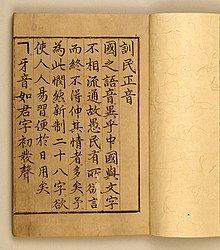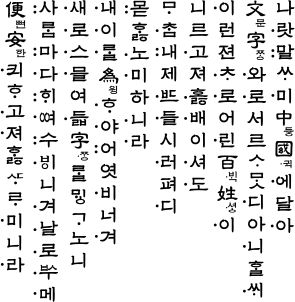Hunminjeongeum
| Hunminjeongeum | |
 | |
| Korean name | |
|---|---|
| Hangul | |
| Hanja | |
| Revised Romanization | Hunminjeong(-)eum |
| McCune–Reischauer | Hunminjŏngŭm |
Hunminjeongeum (lit. The Correct/Proper Sounds for the Instruction of the People) is a document describing an entirely new and native script for the Korean language. The script was initially named after the publication, but later came to be known as hangul. It was created so that the common people illiterate in hanja could accurately and easily read and write the Korean language. It was announced in Volume 102 of the Annals of King Sejong, and its formal supposed publication date, October 9, 1446, is now Hangul Day in South Korea. The Annals place its invention to the 25th year of Sejong's reign, corresponding to 1443-1444.[1]
Content
The publication is written in Classical Chinese and contains a preface, the alphabet letters (jamo), and brief descriptions of their corresponding sounds. It is later supplemented by a longer document called Hunminjeongeum Haerye that is designated as a national treasure No. 70. To distinguish it from its supplement, Hunminjeongeum is sometimes called the "Samples and Significance Edition of Hunminjeongeum" (훈민정음예의본; 訓民正音例義本).
The Classical Chinese (漢文/hanmun) of the Hunminjeongeum has been partly translated into Middle Korean. This translation is found together with Worinseokbo, and is called the Hunminjeongeum Eonhaebon.
The first paragraph of the document reveals King Sejong's motivation for creating hangul:
- Classical Chinese (Original):
- 國之語音
異乎中國
與文字不相流通
故愚民 有所欲言
而終不得伸其情者多矣
予爲此憫然
新制二十八字
欲使人人易習便於日用"耳"(矣)
- Rendered into written Korean (Eonhaebon):[2]
- Translation (metaphrase):
Because the speech of this country is different from that of China, it [the spoken language] does not match the [Chinese] letters. Therefore, even if the ignorant want to communicate, many of them in the end cannot state their concerns. Saddened by this, I have [had] 28 letters newly made. It is my wish that all the people may easily learn these letters and that [they] be convenient for daily use.
- Translation (paraphrase):
The language of [our] people is different from that of the nation of China and thus cannot be expressed by the written language of Chinese people. Because of this reason, the cries of illiterate peasants are not properly understood by the many [in the position of privilege]. I [feel the plight of the peasants and the difficulties faced by the public servants and] am saddened by the situation. Therefore, twenty eight [written] characters have been newly created. [My desire is] such that, each [Korean] person may become familiar [with the newly created written language of Korean] and use them daily in an intuitive way.
Versions
The manuscript of the original Hunminjeongeum has two versions:
- Seven pages written in Classical Chinese, except where the Hangul letters are mentioned, as can be seen in the image at the top of this article. Three copies are left:
- The Eonhaebon, 36 pages, extensively annotated in hangul, with all hanja transcribed with small hangul to their lower right. The Hangul were written in both ink-brush and geometric styles. Four copies are left:
- At the beginning of Worinseokbo (월인석보; 月印釋譜), an annotated Buddhist scripture
- One preserved by Park Seungbin
- One preserved by Kanazawa, a Japanese person
- One preserved by the Japanese Ministry of Royal Affairs
References
- ^ Lee, Iksop; Ramsey, S. Robert (2000). The Korean language. Albany, NY: State Univ. of New York Press. pp. 31–32. ISBN 0791448312.
- ^ a b KTUG.or.kr. "Hunminjeongeum Eonhaebon". Retrieved July 14, 2006. Linked from KTUG's Hanyang PUA Table Project. Based on data from The 21st Century Sejong Project
External links
- Scanned copy of the Eonhae
- Scanned copy of the Eonhae – NAVER website
- The Hunmin Chongum Manuscript – UNESCO Memory of the World International Register web page
- National Memory Heritage Service provides the pictures of the book.


